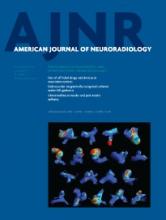Research ArticleBrain
Normal-Appearing White Matter Permeability Distinguishes Poor Cognitive Performance in Processing Speed and Working Memory
A. Eilaghi, A. Kassner, I. Sitartchouk, P.L. Francis, R. Jakubovic, A. Feinstein and R.I. Aviv
American Journal of Neuroradiology November 2013, 34 (11) 2119-2124; DOI: https://doi.org/10.3174/ajnr.A3539
A. Eilaghi
aFrom the Department of Medical Imaging (A.E., P.L.F., R.J., R.I.A.)
cDepartment of Medical Biophysics (A.E.), University of Western Ontario, London, Ontario, Canada
A. Kassner
dDepartment of Medical Imaging (A.K., I.S., R.I.A.), University of Toronto, Toronto, Ontario, Canada
eDepartment of Physiology and Experimental Medicine (A.K.), Hospital for Sick Children, Toronto, Ontario, Canada.
I. Sitartchouk
dDepartment of Medical Imaging (A.K., I.S., R.I.A.), University of Toronto, Toronto, Ontario, Canada
P.L. Francis
aFrom the Department of Medical Imaging (A.E., P.L.F., R.J., R.I.A.)
R. Jakubovic
aFrom the Department of Medical Imaging (A.E., P.L.F., R.J., R.I.A.)
A. Feinstein
bDepartment of Psychiatry (A.F.), Sunnybrook Health Sciences Centre, Toronto, Ontario, Canada
R.I. Aviv
aFrom the Department of Medical Imaging (A.E., P.L.F., R.J., R.I.A.)
dDepartment of Medical Imaging (A.K., I.S., R.I.A.), University of Toronto, Toronto, Ontario, Canada

REFERENCES
- 1.↵
- Barnett MH,
- Sutton I
- 2.↵
- Chiaravalloti ND,
- DeLuca J
- 3.↵
- Filippi M,
- Rocca MA,
- Benedict RH,
- et al
- 4.↵
- Compston A,
- Coles A
- 5.↵
- Soon D,
- Tozer DJ,
- Altmann DR,
- et al
- 6.↵
- Kutzelnigg A,
- Lucchinetti CF,
- Stadelmann C,
- et al
- 7.↵
- Sperling RA,
- Guttmann CR,
- Hohol MJ,
- et al
- 8.↵
- van Buchem MA,
- Grossman RI,
- Armstrong C,
- et al
- 9.↵
- Benedict RH,
- Bruce J,
- Dwyer MG,
- et al
- 10.↵
- Mainero C,
- Caramia F,
- Pozzilli C,
- et al
- 11.↵
- Penny S,
- Khaleeli Z,
- Cipolotti L,
- et al
- 12.↵
- 13.↵
- Zivadinov R,
- Sepcic J
- 14.↵
- 15.↵
- Zeis T,
- Graumann U,
- Reynolds R,
- et al
- 16.↵
- Graumann U,
- Reynolds R,
- Steck AJ,
- et al
- 17.↵
- Lassmann H
- 18.↵
- 19.↵
- 20.↵
- Jackson A,
- Kassner A,
- Annesley-Williams D,
- et al
- 21.↵
- Kassner A,
- Zhu XP,
- Li KL,
- et al
- 22.↵
- 23.↵
- 24.↵
- Robb RA,
- Hanson DP,
- Karwoski RA,
- et al
- 25.↵
- Aviv RI,
- Francis PL,
- Tenenbein R,
- et al
- 26.↵
- Rosen BR,
- Belliveau JW,
- Vevea JM,
- et al
- 27.↵
- 28.↵
- Benedict RH,
- Fischer JS,
- Archibald CJ,
- et al
- 29.↵
- Thompson AJ,
- Polman CH,
- Miller DH,
- et al
- 30.↵
- Heaton RK,
- Nelson LM,
- Thompson DS,
- et al
- 31.↵
- Frischer JM,
- Bramow S,
- Dal-Bianco A,
- et al
- 32.↵
- Benedict RH,
- Cookfair D,
- Gavett R,
- et al
- 33.↵
- Drake AS,
- Weinstock-Guttman B,
- Morrow SA,
- et al
- 34.↵
- Benedict RH,
- Weinstock-Guttman B,
- Fishman I,
- et al
- 35.↵
- Christodoulou C,
- Krupp LB,
- Liang Z,
- et al
- 36.↵
- Lockwood AH,
- Linn RT,
- Szymanski H,
- et al
- 37.↵
- Dineen RA,
- Vilisaar J,
- Hlinka J,
- et al
- 38.↵
- Zivadinov R,
- Bakshi R
- 39.↵
- Zivadinov R,
- Leist TP
- 40.↵
- Filippi M,
- Wolinsky JS,
- Sormani MP,
- et al
- 41.↵
- Silver NC,
- Tofts PS,
- Symms MR,
- et al
- 42.↵
- Rydahl C,
- Thomsen HS,
- Marckmann P
- 43.↵
- 44.↵
- 45.↵
- O'Sullivan M,
- Morris RG,
- Huckstep B,
- et al
- 46.↵
- Parkinson RB,
- Hopkins RO,
- Cleavinger HB,
- et al
- 47.↵
- Kennedy MR,
- Wozniak JR,
- Muetzel RL,
- et al
In this issue
American Journal of Neuroradiology
Vol. 34, Issue 11
1 Nov 2013
Advertisement
A. Eilaghi, A. Kassner, I. Sitartchouk, P.L. Francis, R. Jakubovic, A. Feinstein, R.I. Aviv
Normal-Appearing White Matter Permeability Distinguishes Poor Cognitive Performance in Processing Speed and Working Memory
American Journal of Neuroradiology Nov 2013, 34 (11) 2119-2124; DOI: 10.3174/ajnr.A3539
0 Responses
Normal-Appearing White Matter Permeability Distinguishes Poor Cognitive Performance in Processing Speed and Working Memory
A. Eilaghi, A. Kassner, I. Sitartchouk, P.L. Francis, R. Jakubovic, A. Feinstein, R.I. Aviv
American Journal of Neuroradiology Nov 2013, 34 (11) 2119-2124; DOI: 10.3174/ajnr.A3539
Jump to section
Related Articles
Cited By...
- No citing articles found.
This article has not yet been cited by articles in journals that are participating in Crossref Cited-by Linking.
More in this TOC Section
Similar Articles
Advertisement











